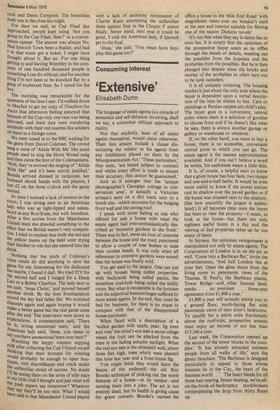Consuming interest
'Extensive'
Elisabeth Dunn
The language of estate agents is a miracle of semantics and self-delusion involving, shall we say, a somewhat oblique approach to reality.
Not that anybody, least of all estate agents themselves, would claim otherwise. Their lists always include a clause dissociating the vendor or his agents from any inhibitions placed on them by the Misrepresentation Act : 'These particulars,' they state, 'are issued subject to contract and whilst every effort is made to ensure their accuracy, this cannot be guaranteed.'
And so it emerges that the 'unique photographer's Georgian cottage in conservation area', is actually a Victorian artisan's semi on a dirt track next to a bomb site—which accounts for the bulging front wall and the caving roof.
I speak with some feeling as one who offered for sale a house with what the estate agent had over-enthusiastically described as 'extensive gardens to the front.' There was in fact, some six foot of concrete between the house and the road, punctured to allow a couple of rose bushes to raise their modest heads: It was only when all references to extensive gardens were erased that the house was finally sold.
You get used to the jargon. One can put up with houses being called properties, with backyards being called patios, the sometime coal-hole being called the utility room. But what is intolerable is the lyricism and the adjectival haemorrhages suffered by most estate agents. In the end, they must be bad for business, for there is no pique to compare with that of the disappointed house-purchaser. When faced with a description of a 'walled garden with apple, pear, fig trees and vine' the mind's eye sees a secret refuge where the fruit can be plucked from the trees in the fading autumn sunlight. What the real eye sees is the aforesaid wall, about three feet high, trees which were planted this time last year and a frost-bitten fig.
You might think they would learn the lesson of the undersell—the old Roy Brooks technique of picking out the worst features of a house—or its vendor—and turning them into a joke. The art is not entirely dead, but its health is giving cause for grave concern. Brooks's current list offers a house in the Mile End Road 'with magnificent views over car breaker's yard at the rear and interior suitable for filming one of the nastier Dickens novels'.
It's not that what they say is damn lies or even lies. It is simply that the optimism of the prospective buyer soars as he riffles through the sheafs of details, weeding out the possibles from the hopeless and the probables from the possibles. But he is then plunged into despair since the bricks and mortar of the probables so often turn out to be rank outsiders.
It is all uniquely irritating. The housing market is just about the only area where the buyer is dependent upon a verbal description of the item he wishes to buy. Cars or paintings or Persian carpets are child's play. The buyer goes to a convenient, central point where there is a selection of goodies to choose from and if he doesn't like what he sees, there is always another garage or gallery or warehouse or whatever.
If, on the other hand, you want to buy a house, there is no accessible, convenient central point to which you can go. The estate agent is the nearest approximation available. And if you can't believe a word he writes, his usefulness wears a little thin.
It is, of course, a helpful start to know that a given house has four beds, two receps and one-and-a-half baths. It would be even more useful to know if the power station cast its shadow over the paved garden or if the house was situated next to the abattoir. (See how smoothly the jargon is assimilated.) It all becomes clear once the buyer has been to view the property—I mean, to look at the house—but there are only eighteen useful hours in a day and the viewing of dud properties takes up far too many of them.
In fairness, the optimism swingometer is manipulated not only by estate agents. The Corporation of London is in on the act as well. 'Come into a Barbican flat,' invite the advertisements, 'And half London lies at your feet. Open the glass doors from the living room to panoramic views of the Thames, St Paul's, the Barbican piazza, Tower Bridge—and other famous land marks . . no premium . . . three-year agreement from £1,800 a year.'
£1,800 a year will actually entitle you to a ground floor, north-facing flat with panoramic views of next door's bedrooms. To qualify for a perch even fractionally above the roof-tops, prospective tenants must enjoy an income of not less than £13,346 a year.
Last week, the Corporation opened up the second of the tower blocks in the complex: 'It has already attracted eminent people from all walks of life,' says the glossy brochure. 'The Barbican is designed particularly to appeal to those whose interests lie in the City, the heart of the business world . ..' The heart bleeds for all those hair-tearing, breast-beating, we're-allon-the-brink-of-bankruptcy stockbrokers contemplating the drop from thirty floors up.


































 Previous page
Previous page